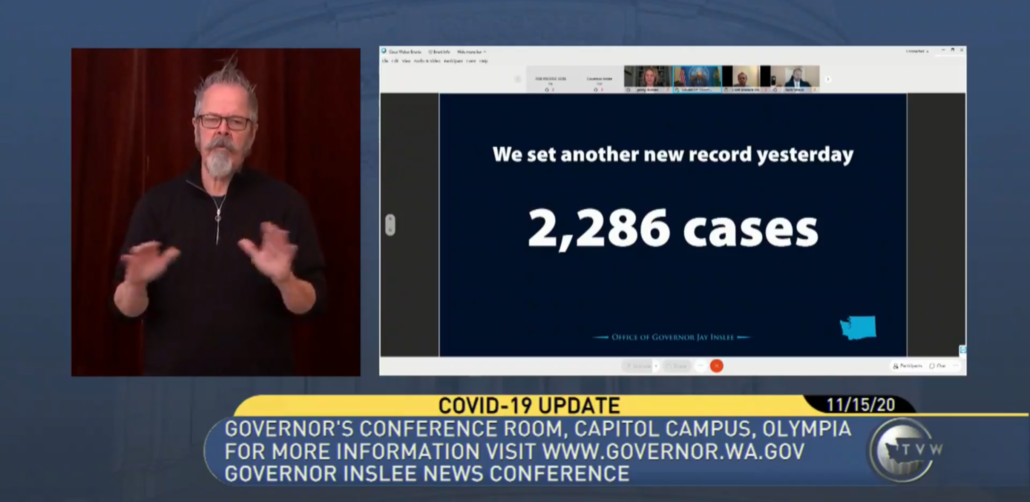Olympia, WA — Governor Jay Inslee announced today a new statewide reopening plan for 2021.
“Today we are announcing a new plan — called Healthy Washington — to move forward in 2021 once we see COVID activity reduce, hospitals that aren’t overrun with COVID patients, people continuing to mask, and all the other personal steps we know work to prevent infection,” Inslee said.
Inslee made it clear the state is not moving forward in a big way today, but he said that a new plan is needed. This new reopening plan goes into effect Jan. 11, 2021, and includes a “small resumption” of some activities across the state.
In contrast to last year’s Safe Start program, this plan has two phases at inception. More phases will be added when COVID activity is significantly reduced, Inslee said. Another big change is that Healthy Washington will also be governed by region, not by county.
“Because we know that health care systems are regional and we know that the virus does not respect county boundaries,” Inslee said. He added that this makes sense from both a public health perspective and a “health care delivery” one, as well.
Counties will be grouped into eight regions based on health system resources over a geographic area, the governor explained. The four metrics to track progress will be COVID-19 hospitalizations, ICU capacity, case data, and test positivity.
“All four targets have to be met for a region to reopen more activities,” Inslee said.
All regions will start in Phase 1, according to Inslee. There is no application for moving to Phase 2, but rather will be decided based on information regularly collected by the Washington State Department of Health (DOH). In order to advance, regions must show a 10 percent decreasing trend in case rates; a 10 percent decrease in COVID hospital admission rates; an ICU occupancy rate that’s less than 90 percent; and a test positivity rate of less than 10 percent.
In Phase 2, restaurants may open indoor dining at 25 percent capacity; this also applies to indoor fitness centers. Sports competitions may also resume in Phase 2 with audience limits. Wedding and funeral ceremonies will be able to increase their capacities from current limits, as well.
“It allows us to now see a path forward,” said Dr. Umair Shah, the state Secretary of Health, who joined today’s conference call. “We are not there yet as a state, we are all committed to getting there, though, as a state.”
Shah did say the possibility exists that regions could move backward from Phase 2 to Phase 1. The DOH will closely monitor the data, and Shah said DOH will start posting the most recent analyses each Friday, beginning this week. Phase upgrades will be announced on Mondays.

To remain in Phase 2, regions must meet at least 3 metrics:
- Decreasing or flat trend in two-week rate of COVID-19 cases per 100K population
- Decreasing or flat trend in two-week rate new COVID-19 hospital admission rates per 100K population
- ICU occupancy (total — COVID-19 and non-COVID-19) of less than 90%
- COVID-19 test positivity rate of <10%.
“We do not want to fear COVID-19, but we have to respect COVID-19,” Shah said. “It has been a formidable foe throughout this last year, and we have to do everything we can to move forward.”
The eight regions are as follows:
- Central: King, Pierce, Snohomish
- East: Adams, Asotin, Ferry, Garfield, Lincoln, Pend Oreille, Spokane, Stevens, Whitman
- North: Island, San Juan, Skagit, Whatcom
- North Central: Chelan, Douglas, Grant, Okanogan
- Northwest: Clallam, Jefferson, Kitsap, Mason
- South Central: Benton, Columbia, Franklin, Kittitas, Walla Walla, Yakima
- Southwest: Clark, Cowlitz, Klickitat, Skamania, Wahkiakum
- West: Grays Harbor, Lewis, Pacific, Thurston

Inslee said Washington has avoided overwhelming the state’s health care systems throughout this pandemic so far through rigorous safety measures, such as physical distancing and masking, as well as social and economic restrictions. This new recovery system aims to safely ease some restrictions while also maintaining crucial hospital capacity, ensuring care for Washingtonians that need it and paving the way for economic recovery.
“No one was untouched by the effects of the pandemic in 2020; many have and continue to suffer through no fault of their own,” Inslee said during a press conference Tuesday. “We aren’t out of this yet, but we are close to turning the corner on COVID-19 and this third wave of infection.”








